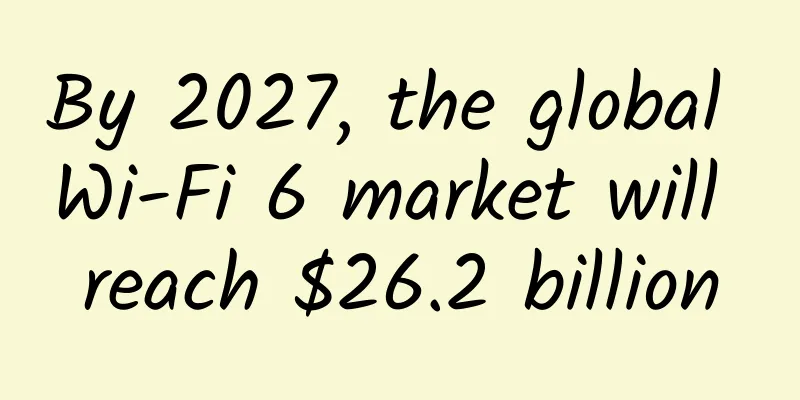By 2027, the global Wi-Fi 6 market will reach $26.2 billion

|
According to market research firm ResearchAndMarkets, the global Wi-Fi 6 market is expected to grow from $11.5 billion in 2022 to $26.2 billion in 2027, with a compound annual growth rate (CAGR) of 17.9% during the forecast period. The Wi-Fi 6 market is gaining momentum due to the increase in the number of Internet users. The development of various Wi-Fi enabled devices in the market has increased consumer demand, which in turn has boosted the sales of smart home and work devices. Devices such as lighting systems and thermostats have been installed in homes and workplaces in developed countries such as the U.S., Japan, and Germany. Developed countries are witnessing large-scale deployment of smart home security and other in-vehicle infotainment devices. Smart devices need to connect with other devices through homogeneous or heterogeneous networks. Wi-Fi 6 makes integration and interconnection with other devices simple and easy. With “smart” technology integrated into devices, consumers can operate them remotely to manage their operations. Wi-Fi capabilities are a mandatory requirement for devices that support smart technology. Over time, the IEEE standard has also evolved from 802.11 to 802.11ax. In addition, Wi-Fi 6 increases the speed of wireless connections. Hardware will still account for a larger market share during the forecast periodThe Wi-Fi 6 market is segmented into hardware, solutions, and services. The hardware segment includes WAPs, mesh routers, home gateways, and wireless repeaters. Services include professional services and managed services. The growing demand for Wi-Fi 6 solutions and services and the increasing need for improved connectivity among enterprises are driving the growth of the global Wi-Fi 6 market. Asia Pacific to grow at the highest CAGR during the forecast periodAsia Pacific is home to many developing economies, and many countries in the region are adopting new technologies to comply with procedures to improve the efficiency of the financial system. Key countries include Australia, Japan, Singapore, India, China, and New Zealand. The region is expected to witness rapid adoption of Wi-Fi 6 software. Asia Pacific is expected to be the fastest growing Wi-Fi 6 market due to the increase in new technology adoption, high investments in digital transformation, rapid expansion of domestic enterprises, extensive infrastructure development, and rising GDP in various countries. Fast-growing economies such as China, Japan, Singapore, and India are implementing Wi-Fi 6 solutions across multiple business processes to provide effective solutions. Key Trends
Market DynamicsDrivers:
Impediments:
Chance:
challenge:
|
<<: How to deal with the nightmare of network outage
>>: Why is 6G research and development important in the digital economy era?
Recommend
5G is here! How long will it take for it to be truly universally adopted?
4G, the mobile network that allows us to make cal...
RAKsmart cloud server $1.99/month, Hong Kong/Japan/Singapore/Los Angeles/San Jose data center
RAKsmart cloud servers also participate in the ye...
NDRC: Accelerate the layout of new infrastructure such as 5G and the Internet of Things
On May 24, Ning Jizhe, deputy director of the Nat...
TCP waves four times: Why four times? The principle is revealed!
introduction Hello, everyone. I am your technical...
RAKsmart: 50% off all VPS hosting, VPS in Hong Kong/Japan/San Jose starting from $2.63 per month
We often share RAKsmart's product information...
The price of 4G mobile chips will rise instead of fall in the second half of 2021
As mobile chip suppliers focus more on 5G solutio...
Four ways to ensure service availability in the face of traffic bursts
Preface Have you ever had this experience? A larg...
Let’s talk about 5G dynamic spectrum sharing?
What is 4G/5G dynamic spectrum sharing? Why is 4G...
A world first! Traffic lights are used as 5G base stations: Japan has come up with a wave of cool operations
The small signal coverage range of 5G base statio...
Hybrid office becomes a trend. Cisco uses intelligent technology to improve office experience
According to the survey results of Cisco and a th...
In order to improve network reliability, do you know how hard we work on protecting the OTN optical layer?
Optical fiber is an important part of communicati...
5G is here, and you can’t hide from it
5G has gradually entered our lives with the resea...
6 AI Elements You Need for a Wireless Network Strategy
Thanks to advances in artificial intelligence (AI...
"Rehabilitate" the Ethernet all-optical network! China Construction Association publishes the first standardization document for smart park construction
"Smart Park" is not a new concept. In t...
The cancellation of data roaming charges has become inevitable, but do operators still have to wait until they get punished?
There is a theme every year. Once one is solved, ...









